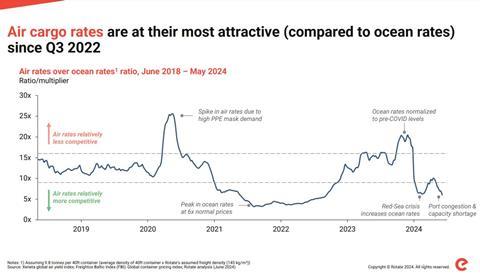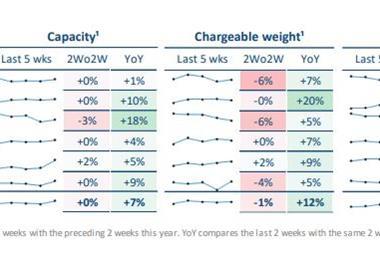The difference between ocean and airfreight rates has narrowed to its lowest level since the third quarter of 2022 as container supply chains continue to come under pressure.
Writing on LinkedIn, data provider Rotate's Tim van Leeuwen and Mels Wittenburg pointed out that on a global level ocean rates are now only six times lower than airfrieght rates.
This means airfreight rates are at their most attractive compared with ocean since the third quarter of 2022 when a period of port congestion and container shortages caused a spike in container shipping pricing.
The two also pointed out that historically, airfreight rates are around 12-15 times more expensive than ocean.
The spike in box rates comes as ocean shipping – already under pressure due to the Red Sea crisis – has seen volumes and rates soar due to unseasonal capacity shortages and port congestion.

At present, it is not clear whether this will result in rising airfreight demand, with Xeneta chief airfreight officer Niall van de Wouw suggesting that the issues on the ocean are due to shippers front-loading peak season cargo to avoid the third quarter rush in an already strained market.
If this is the case, the speed of airfreight will not yet be required.
Data provider WorldACD, meanwhile, said that the situation was already putting extra pressure on air cargo.
“Those disruptions to container shipping services, in part caused by the attacks on vessels in the Red Sea, have been exacerbated further in recent weeks due to port congestion and vessel capacity shortages in certain key markets, driving more cargo owners to air cargo solutions,” it said.
A chart (see above) produced by Rotate shows dramatic swings in the difference in air and ocean pricing over the last 12 months.
In the third quarter of last year, a surge in e-commerce demand and a calmer ocean market resulted in the price difference between the two spiking at around 20 times.
This then rapidly narrowed at the start of this year when the Red Sea crisis resulted in a spike in ocean rates as carriers re-organised shipping routes around the southern tip of Africa to avoid missile attacks.
The recent surge in box shipping demand and capacity shortages was a surprise as spring/early summer is usually a quiet time of year.
Freight forwarder DSV in May said the impact of elongated sailing times around Africa to avoid missile attacks in the Red Sea on capacity levels was starting to worsen despite extra ships being added to the market.
“The weekly capacity offered from Asia to Europe is about 10% lower than the same period last year, even though significantly more vessels and thus more capacity are being used to operate a network,” the forwarder explained.
“Perhaps the most important factor causing the pressure we are experiencing on the market is congestion at many central ports around the world.”
DSV said it expects the issues to continue until at least July.
Supporting documents
Click link to download and view these files1718780386102
PDF, FileSizeText 83.02 kb














